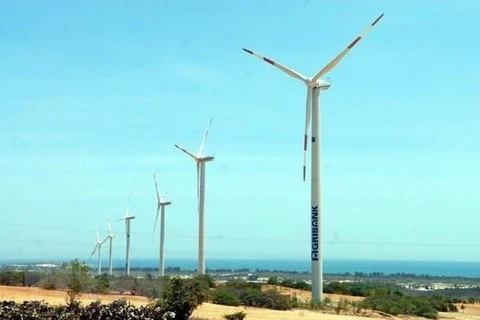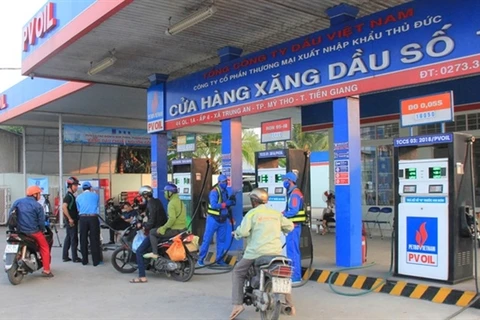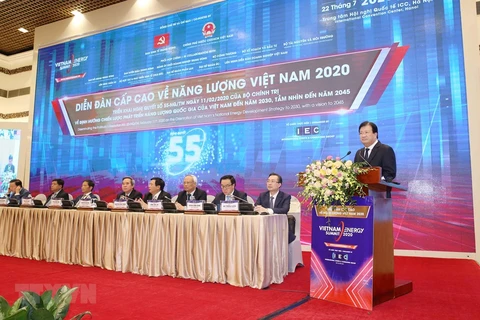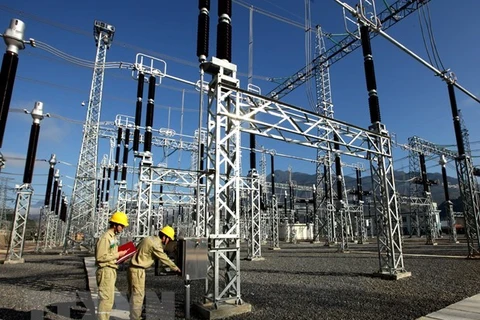 Deputy Minister of Industry and Trade Dang Hoang An speaks at the first workshop on the National Energy Master Plan (NEMP) for 2021-2030 period (Photo: VietnamPlus).
Deputy Minister of Industry and Trade Dang Hoang An speaks at the first workshop on the National Energy Master Plan (NEMP) for 2021-2030 period (Photo: VietnamPlus).
Hanoi (VNA) - The Ministry of Industry and Trade has asked for stronger efforts to ensure national energy security, prioritise rapid and sustainable energy development in connection with protecting ecological environment, and ensuring national defence and security.
The MoIT has also requested the consulting units to implement specific tasks in the National Energy Planning in the time to come.
The energy demand for domestic production and consumption is forecast to continue increasing in the future. However, many fossil energy sources such as coal, oil and gas are gradually exhausted, greatly affecting efforts to ensure energy security in the absence of additional and alternative sources.
At the workshop, representatives from the MoIT asked the consulting agencies to adhere to the Politburo's Resolution 55 on ensuring national energy security, saying that this is a key task throughout the national industrialisation and modernisation.
Decreasing output reported at most oil and gas fields
According to reports of the Vietnam Petroleum Institute (VPI), Vietnam has met and exceeded the set targets in exploring and exploiting oil and gas for 2020.
Notably, Vietnam has increased reserves to 10-20 million tonnes of oil equivalent products per year, while domestic oil and gas exploitation outputs reached from 10-15 million tonnes, and 10-11 billion cu.m per year, respectively, meeting approximately 70 percent of the demand for petroleum products.
However, it has also failed to realise some targets, such as the oil exploitation abroad, which has been lower than 2-3 million tonnes per year, and the production of liquefied petroleum gas (LPG) has been 20 percent lower than the set plan.
Dr. Nguyen Anh Duc from the VPI attributed the results to declining production at oil and gas fields and complex mining activities.
Additionally, the phenomenon of water intrusion is difficult to predict. Some gas fields with high condensate content have had condensate deposition after a period of exploitation, resulting in a decrease in both gas and condensate outputs.
In addition, a number of oil and gas processing projects with single planning and small scale has low global competitiveness.
Energy pricing policy often focuses on satisfying the demand and addressing social impacts rather than promoting the supply development, and the policy has not been operated in line with a modern and adequate market mechanism, a representative from the VPI said.
Participants said that the power planning is related to that of industries such as coal, oil-gas, renewable energy, transport, industrial development, and socio-economic development, but in fact it is difficult to harmonise the planning.
Dr. Nguyen Anh Tuan from the VPI said the planning management over the recent past has met difficulties in adjusting in time.
Many non-EVN power projects have been behind schedule, greatly affecting the supply-demand and electricity supply security, reaching only 15,500 MW for the 2016-2020 period from the 21,650-MW target.
“Flexible" adjustment plan needed
In the source capacity structure in 2019, coal thermal power still accounted for the highest proportion with 36.2 percent, followed by hydroelectricity – 30.3 percent. Notably, renewable energy has recorded rapid changes thanks to preferential mechanisms for this field.
Statistics of the Institute of Energy show that by the end of 2019, 13 wind power projects had been operated across the country, with a total installed capacity of 420 MW. There are four projects with a total installed capacity of 138 MW that have been under construction in the central province of Ninh Thuan, the Central Highlands province of Dak Lak and the Mekong Delta province of Soc Trang.
As of mid-June 2019, 332 solar power projects with a combined capacity of 26,290 MWp were proposed for construction, and 154 projects with a total capacity of 13,076 MWp approved for adding to the planning.
Power purchase agreements were signed for 127 projects with a total capacity of 8,470 MWp, while 87 projects commercially operated with a total capacity of 5,385 MWp. After June 30, two more projects with a combined capacity of 5,485 MWp were put into commercial operation.
The development of renewable energy sources plays a huge role in adding power sources to the national power system.
However, experts from the Institute of Energy recommend that renewable energy planning should be more oriented to fully exploit the potential of this industry, saying that it is necessary to proactively make early strategic directions, and to build many scenarios to avoid being passive in operating and making supporting policies.
MOIT Deputy Minister An stressed the need to have new thinking and policies to match trends as well as socio-economic development requirements.
According to Ngo Thuy Quynh, deputy director of MoIT’s oil, gas and coal department, the content of the energy master plan must ensure a concerted, complete and appropriate integration on the basis of relevant contents in the national master plan, and the national land use planning.
Additionally, the National Energy Master Plan should be placed in relation to other plans in accordance with provisions of the Law on Planning, she added.
The MoIT has urged the consulting sides to complete the report on the National Energy Master Plan for appraisal and submission to the Prime Minister in the fourth quarter of 2020.
According to the result of the contractor selection, the selected consultants for building the National Energy Master Plan is a joint venture of the Institute of Energy and the VPI - the two leading consulting units that have a lot of experience in building national plans in the energy field./.
























